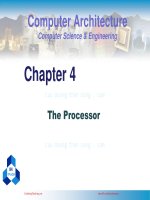kiến trúc máy tính võ tần phương ex1 solution 071 sinhvienzone com
Bạn đang xem bản rút gọn của tài liệu. Xem và tải ngay bản đầy đủ của tài liệu tại đây (35.54 KB, 8 trang )
ICS 233 - Computer Architecture
& Assembly Language
Exam I – Fall 2007
Saturday, November 3, 2007
7:00 – 9:00 pm
Computer Engineering Department
College of Computer Sciences & Engineering
King Fahd University of Petroleum & Minerals
Student Name:
SOLUTION
Student ID:
Q1
/ 15
Q2
/ 15
Q3
/ 15
Q4
/ 10
Q5
/ 10
Q6
/ 15
Q7
/ 20
Total
/ 100
Important Reminder on Academic Honesty
Using unauthorized information or notes on an exam, peeking at others work, or
altering graded exams to claim more credit are severe violations of academic
honesty. Detected cases will receive a failing grade in the course.
Prepared by Dr. Muhamed Mudawar
CuuDuongThanCong.com
Page 1 of 8
/>
Page 2 of 8
Q1. (15 pts) Find the word or phrase that best matches the following descriptions:
a)
Program that manages the resources of a computer for the benefit of the programs that
run on that machine.
Operating System
b)
Program that translates from a high-level notation to assembly language.
Compiler
c)
Component of the processor that tells what to do according to the instructions.
Control Unit
e)
Interface that the hardware provides to the software.
Instruction Set Architecture
d)
Microscopic flaw in a wafer.
Defect
f)
Rectangular component that results from dicing a wafer.
Die
g)
Computer inside another device used for running one predetermined application or
collection of software.
Embedded System
h)
(3 pts) In a magnetic disk, the disks containing the data are constantly rotating. On
average, it should take half a rotation for the desired data on the disk to spin under the
read/write head. Assuming that the disk is rotating at 10000 RPM (Rotations Per
Minute), what is the average time for the data to rotate under the disk head?
Average rotational latency = 1/2 * 60 * 1000 (msec /min) / 10000 = 3 milliseconds
i)
(5 pts) Assume you are in a company that will market a certain IC chip. The cost per
wafer is $5000, and each wafer can be diced into 1200 dies. The die yield is 40%.
Finally, the dies are packaged and tested, with a cost of $9 per chip. The test yield is
80%; only those that pass the test will be sold to customers. If the retail price is 50%
more than the cost, what is the selling price per chip?
Number of working dies per wafer = 1200 * 0.4 = 480
Packaging cost = 480 * $9 = $4320
Number of working chips that will be sold to customers = 480 * 0.8 = 384
Cost per chip = ($5000 + $4320) / 384 = $24.27
Selling price per chip = $24.27 * 1.5 = $36.4
CuuDuongThanCong.com
/>
Page 3 of 8
Q2.
(15 pts) Consider the following data definitions:
.data
var1:
.byte
var2:
.half
var3:
.word
.align 3
str1:
.asciiz
a)
3, -2, 'A'
1, 256, 0xffff
0x3de1c74, 0xff
"ICS233"
Show the content of each byte of the allocated memory, in hexadecimal for the above
data definitions. The Little Endian byte ordering is used to order the bytes within words
and halfwords. Fill the symbol table showing all labels and their starting address. The
ASCII code of character 'A' is 0x41, and '0' is 0x30. Indicate which bytes are skipped or
unused in the data segment.
Data Segment
Address
Byte 0 Byte 1 Byte 2 Byte 3
0x10010000 0x03
0xfe
0x41
--
Unused
0x10010004 0x01 0x00 0x00 0x01
0x10010008 0xff
0xff
--
--
0x1001000C 0x74
0x1c
0xde
0x03
0x10010010 0xff
0x00
0x00
0x00
--
--
--
Symbol Table
0x10010014
--
0x10010018 0x49
0x43
0x53
0x1001001C 0x33
0x33
0x00
0x10010020
0x32
Label
Address
var1
0x10010000
var2
0x10010004
var3
0x1001000C
str1
0x10010018
0x10010024
0x10010028
0x1001002C
b)
How many bytes are allocated in the data segment including the skipped bytes?
31 Bytes including the skipped ones
CuuDuongThanCong.com
/>
Page 4 of 8
Q3. (15 pts) For each of the following pseudo-instructions, produce a minimal sequence of
real MIPS instructions to accomplish the same thing. You may use the $at register only
as a temporary register.
a)
abs
$s1, $s2
addu $s1, $zero, $s2
bgez $s2, next
subu $s1, $zero, $s2
next:
b)
addiu $s1, $s2, imm32
# imm32 is a 32-bit immediate
lui $at, upper16
ori $at, $at, lower16
addu $s1, $s2, $at
c)
bleu $s1, $s2, Label
# branch less than or equal unsigned
sltu $at, $s2, $s1
beq $at, $zero, Label
d)
bge $s1, imm32, Label
lui
ori
slt
beq
e)
$at,
$at,
$at,
$at,
upper16
$at, lower16
$s1, $at
$zero, Label
rol $s1, $s2, 5
srl $at, $s2, 27
sll $s1, $s2, 5
or $s1, $s1, $at
CuuDuongThanCong.com
# imm32 is a 32-bit immediate
# rol = rotate left $s2 by 5 bits
32-bit register
/>
Page 5 of 8
Q4. (10 pts) Translate the following loop into assembly language where a and b are integer
arrays whose base addresses are in $a0 and $a1 respectively. The value of n is in $a2.
for (i=0; i
a[i] = a[i-2] + a[i-1] + b[i];
}
else {
a[i] = b[i]
}
}
loop:
else:
li
beq
lw
bgt
lw
lw
addu
addu
sw
addiu
addiu
addiu
bne
$t0,
$a2,
$t1,
$t0,
$t2,
$t3,
$t2,
$t1,
$t1,
$a0,
$a1,
$t0,
$t0,
0
$0, skip
0($a1)
2, else
-8($a0)
-4($a0)
$t2, $t3
$t2, $t1
0($a0)
$a0, 4
$a1, 4
$t0, 1
$a2, loop
#
#
#
#
#
#
#
#
#
#
#
#
$t0 = i = 0
skip loop if n is zero
$t1 = b[i]
if (i>2) goto else
$t2 = a[i-2]
$t3 = a[i-1]
$t2 = a[i-2]+a[i-1]
$t1 = a[i-2]+a[i-1]+b[i]
a[i] = $t1
advance array a pointer
advance array b pointer
i++
skip:
CuuDuongThanCong.com
/>
Page 6 of 8
Q5. (10 pts) Translate the following if-else statement into assembly language:
if (($t0 >= '0') && ($t0 <= '9')) {$t1 = $t0 – '0';}
else if (($t0 >= 'A') && ($t0 <= 'F')) {$t1 = $t0+10-'A';}
else if (($t0 >= 'a') && ($t0 <= 'f')) {$t1 = $t0+10-'a';}
blt
$t0, '0', else1
bgt
$t0, '9', else1
addiu $t1, $t0, -48
j
# '0' = 48
next
else1:
blt
$t0, 'A', else2
bgt
$t0, 'F', else2
addiu $t1, $t0, -55
j
# 10-'A' = 10-65=-55
next
else2:
blt
$t0, 'a', next
bgt
$t0, 'f', next
addiu $t1, $t0, -87
# 10-'a' = 10-97=-87
next:
CuuDuongThanCong.com
/>
Page 7 of 8
Q6. The following code fragment processes two arrays and produces an important result in
register $v0. Assume that each array consists of N words, the base addresses of the
arrays A and B are stored in $a0 and $a1 respectively, and their sizes are stored in $a2
and $a3, respectively.
outer:
inner:
skip:
a)
sll
sll
addu
addu
addu
lw
addu
addu
lw
bne
addiu
addiu
bne
addiu
bne
$a2,
$a3,
$v0,
$t0,
$t4,
$t4,
$t1,
$t3,
$t3,
$t3,
$v0,
$t1,
$t1,
$t0,
$t0,
$a2, 2
$a3, 2
$zero, $zero
$zero, $zero
$a0, $t0
0($t4)
$zero, $zero
$a1, $t1
0($t3)
$t4, skip
$v0, 1
$t1, 4
$a3, inner
$t0, 4
$a2, outer
(5 pts) Describe what the above code does and what will be returned in register $v0.
This code compares every element in the first array against
all elements of the second array. It counts the number of
matching elements between the two arrays.
$v0 will contain the count of the number of matching
elements between the two arrays.
b)
(10 pts) Write a loop that calculates the first N numbers in the Fibonacci sequence (1, 1,
2, 3, 5, 8, 13, …), where N is stored in register $a0. Each element in the sequence is the
sum of the previous two. Declare an array of words and store the generated elements of
the Fibonacci sequence in the array.
.data
fibs: .space 200
# space for 50 integers
.text
.globl main
main:
# you can read N from the input
la
$t0, fibs
li
$t1, 1
li
$t2, 1
L1:
sw
$t1, 0($t0)
addu
$t3, $t1, $t2
move
$t1, $t2
move
$t2, $t3
addiu $t0, $t0, 4
addiu $a0, $a0, -1
bne
$a0, $zero, L1
CuuDuongThanCong.com
/>
Page 8 of 8
Q7. (20 Pts) Write MIPS assembly code for the procedure BinarySearch to search an array
which has been previously sorted. Each element in the array is a 32-bit signed integer.
The procedure receives three parameters: register $a0 = address of array to be
searched, $a1 = size (number of elements) in the array, and $a2 = item to be searched. If
found then BinarySearch returns in register $v0 = address of the array element where
item is found. Otherwise, $v0 = 0.
BinarySearch ($a0=array, $a1=size, $a2=item) {
lower = 0;
upper = size-1;
while (lower <= upper) {
middle = (lower + upper)/2;
if (item == array[middle])
return $v0 = ADDRESS OF array[middle];
else if (item < array[middle])
upper = middle–1;
else
lower = middle+1;
}
return $v0=0;
}
BinarySearch:
li
$t0,
addiu
$t1,
loop:
bgt
$t0,
addu
$t2,
srl
$t2,
sll
$v0,
addu
$v0,
lw
$t3,
bne
$a2,
jr
$ra
else1:
bgt
$a2,
addiu
$t1,
j
loop
else2:
addiu
$t0,
j
loop
ret:
andi
$v0,
jr
CuuDuongThanCong.com
$ra
0
$a1, -1
$t1, ret
$t0, $t1
$t2, 1
$t2, 2
$a0, $v0
0($v0)
$t3, else1
# $t0 = lower index
# $t1 = upper index
#
#
#
#
#
#
#
$t2 = lower+upper
$t2 = (lower+upper)/2
$v0 = middle*4
$v0 = address array[middle]
$t3 = value array[middle]
(item == array[middle])?
return
$t3, else2
$t2, -1
# (item < array[middle])?
# upper = middle-1
$t2, 1
# lower = middle+1
$v0, 0
# $v0 = 0
# return
/>









